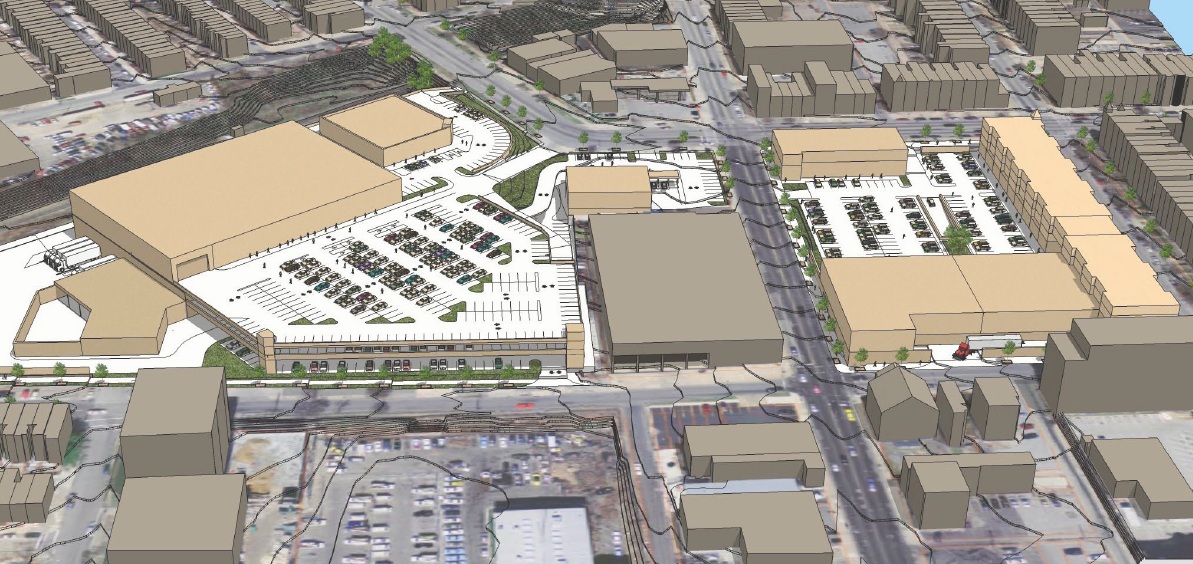
In November 2009, WV Urban Developments LLC presented their plans to develop the former Anderson Automotive Site with a Lowe’s, a grocery store, 32,000 square feet of retail, and up to 60 apartments in an area of approximately 11 acres bounded by 25th Street to the north, Maryland Avenue to the east, 24th Street to the south and the CSX rail line to the west (map). The developer’s presentation to the community is available on the Charles Village Civic Association website here (PDF). After meetings with the Remington Neighborhood Alliance, the Greater Remington Improvement Association, the Charles Village Civic Association, and the Old Goucher Community Association the proposal was covered in a series of posts on Baltimore Brew, in the Baltimore Sun, and The Alligator, a Remington neighborhood blog. While the prospect of expanding neighborhood amenities, new jobs, and broader economic development is exciting, Baltimore Heritage has significant concerns regarding the proposed demolition of the former Royer’s Hill Methodist Episcopal Church at the southeast corner. This 1891 stone building began as a mission of the Lovely Lane Methodist Church and still serves as a landmark within the Remington neighborhood. We believe that this stone building, which retains significant historic character, should be preserved and utilized to help establish a successful transition between the large commercial development and the historic residential Remington neighborhood.
The Royer’s Hill or 24th Street ME Church was constructed in 1891 to serve the congregation of the Royer’s Hill Chapel established at the site in December 1885. The new building followed the move by the First Methodist Episcopal Church (Lovely Lane Methodist Church) from their original location downtown to 22nd and St. Paul Streets. Despite opposition by two-thirds of church members, Rev. John F. Goucher led the effort to move out to the suburbs into a a new building designed by Stanford White. In When Church Became Theatre, Jeanne Halgren Kilde describes the changing mission that accompanied the move,
“By November 1887, the new church listed three mission churches to its credit: the Royer Hill Church, the Guilford Avenue Sunday School and Chapel, and the Oxford Church and Sunday School. Thus, the physical distance between the middle-class members of the congregation and the urban working classes allowed a two-pronged mission to arise: a family ministerial and worship mission focused on the pastoral needs of the suburban members and an outreach mission focused on the perceived religious, moral, and social deficiencies of the urban population.”[1]
Born in Baltimore on February 6, 1861, Rev. Edward L. Watson joined the pastorate of the First ME Church in 1885 under Rev. John F. Goucher and was assigned “special charge” over the Royer Hill Church. After six years with the church, Watson oversaw “the erection of the Twenty-fourth Street Church.”[2] The transition from a small mission to an established church followed a pattern in the city, as an 1886 account in The Sun noted,
“Not content with carrying on their work within their own borders, many of the churches have established flourishing missions, which have gradually grown to church dimensions, and the needs of the times have demanded new buildings for some of the older churches.”
Listing a number of “new departures already completed, just begun or nearing completion,” the article identified “Royer’s Hill Church, in charge of the Rev. E.L. Watson” as an example of this trend.[3]
The building remained actively in use as a Methodist Episcopal Church through the 1930s, but was converted for use as a motor freight station sometime prior to 1951. These changes initially included the addition of a large wraparound porch on the south side of the structure and a large garage door cut into the west face of the building. At this time, the porch has been enclosed with concrete block, windows have been removed and their openings filled, and a section of the south face of the building has been removed.
Despite these changes, however, the building remains an anchor on the corner of 24th Street and Sisson Street and is a rare example of a mission church associated with Lovely Lane United Methodist Church. Though the developer has yet to share a detailed design for the southwest corner of the site, the existing illustration suggests the complete demolition of the church and the construction of a multistory parking structure and truck loading dock facing the historic two-story rowhouses on the south side of 24th Street. Therefore, with consideration for the value of the building and its history to both the site and to the broader community, we urge the preservation and adaptive reuse of the former Royer’s Methodist Episcopal Church. Baltimore Heritage is currently working with community members, including the Remington Neighborhood Alliance, to explore possible preservation solutions for the building and the site.
[1] Jeanne Halgren Kilde, When Church Became Theatre (Oxford University Press US, 2005), 91-92.
[2] John Wesley Hill, Twin city Methodism (Price bros. publishing co., 1895), 327.
[3] “THE CONFERENCE TODAY,” The Sun (1837-1985), October 29, 1889, http://proquest.umi.com/pqdweb?did=1732607012&Fmt=7&clientId=41143&RQT=309&VName=HNP.
